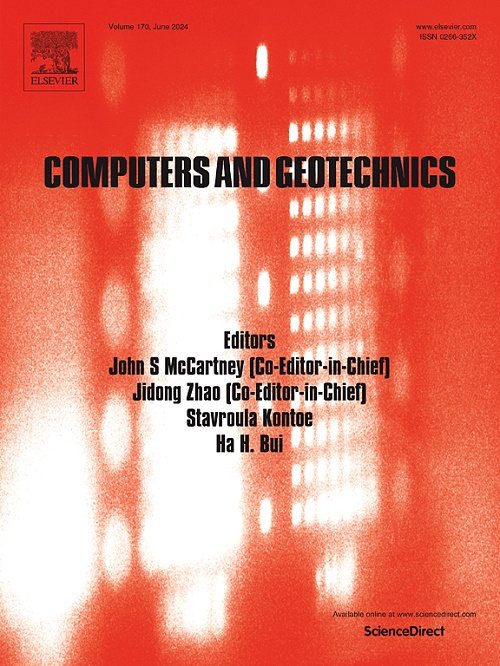IF 5.3
1区 工程技术
Q1 COMPUTER SCIENCE, INTERDISCIPLINARY APPLICATIONS
引用次数: 0
摘要
含甲烷水合物沉积物(HBS)已成为一种前景广阔的能源,深入了解其力学特性对于安全勘探和利用至关重要。以往的研究表明,水合物分布模式和沉积物颗粒与水合物之间的相互作用等微观结构对含甲烷水合物沉积物的力学行为有重大影响。然而,作为决定颗粒-颗粒和颗粒-水合物相互作用行为的最重要因素之一,颗粒形状在以往的研究中未得到充分探讨。本研究采用离散元素法(DEM)模拟不同颗粒角度的 HBS,重点研究颗粒形状对具有不同水合物分布模式(通常称为孔隙习性)的 HBS 力学行为的影响。通过模拟一组三轴试验,我们发现颗粒角度(由球度、圆度和凸度定义)对 HBS 的强度和刚度有显著影响。此外,我们还观察到颗粒角度在初始加载阶段施加的防旋转效应,偏差织物和接触分布的演变也受到颗粒形状的影响。这项综合分析强调了颗粒形状在 HBS 建模中的重要性,并揭示了 HBS 中复杂的颗粒-颗粒和颗粒-水合物相互作用机制,为储层开采提供了宝贵的见解。本文章由计算机程序翻译,如有差异,请以英文原文为准。
Effect of particle shape on the mechanical behavior of methane hydrate-bearing sediments: A DEM study
Methane hydrate-bearing sediments (HBS) have emerged as a promising energy source, and an in-depth understanding of their mechanical properties is critical for safe exploration and utilization. Previous studies have demonstrated the significant effect of microstructures, such as hydrate distribution patterns and sediment particle-hydrate interactions, on the mechanical behavior of HBS. However, as one of the most important factors determining both particle–particle and particle-hydrate interaction behaviors, particle shape has been insufficiently explored in previous studies. This study employs the Discrete Element Method (DEM) to simulate HBS with various particle angularity, focusing on the effect of particle shape on mechanical behavior of HBS with different hydrate distribution patterns (often referred to as pore habits). By simulating a set of triaxial tests, we found that the particle angularity (defined by sphericity, roundness, and convexity) exerts a significant influence on the strength and stiffness of HBS. Moreover, an anti-rotation effect imposed by particle angularity at the initial loading stage is observed, and the evolution of deviatoric fabric and contact distribution is also influenced by particle shape. This comprehensive analysis underscores the importance of particle shape in modeling HBS and unravels the complex particle–particle and particle-hydrate interaction mechanisms in HBS, offering valuable insights for reservoir exploitation.
求助全文
通过发布文献求助,成功后即可免费获取论文全文。
去求助
来源期刊

Computers and Geotechnics
地学-地球科学综合
CiteScore
9.10
自引率
15.10%
发文量
438
审稿时长
45 days
期刊介绍:
The use of computers is firmly established in geotechnical engineering and continues to grow rapidly in both engineering practice and academe. The development of advanced numerical techniques and constitutive modeling, in conjunction with rapid developments in computer hardware, enables problems to be tackled that were unthinkable even a few years ago. Computers and Geotechnics provides an up-to-date reference for engineers and researchers engaged in computer aided analysis and research in geotechnical engineering. The journal is intended for an expeditious dissemination of advanced computer applications across a broad range of geotechnical topics. Contributions on advances in numerical algorithms, computer implementation of new constitutive models and probabilistic methods are especially encouraged.
 求助内容:
求助内容: 应助结果提醒方式:
应助结果提醒方式:


